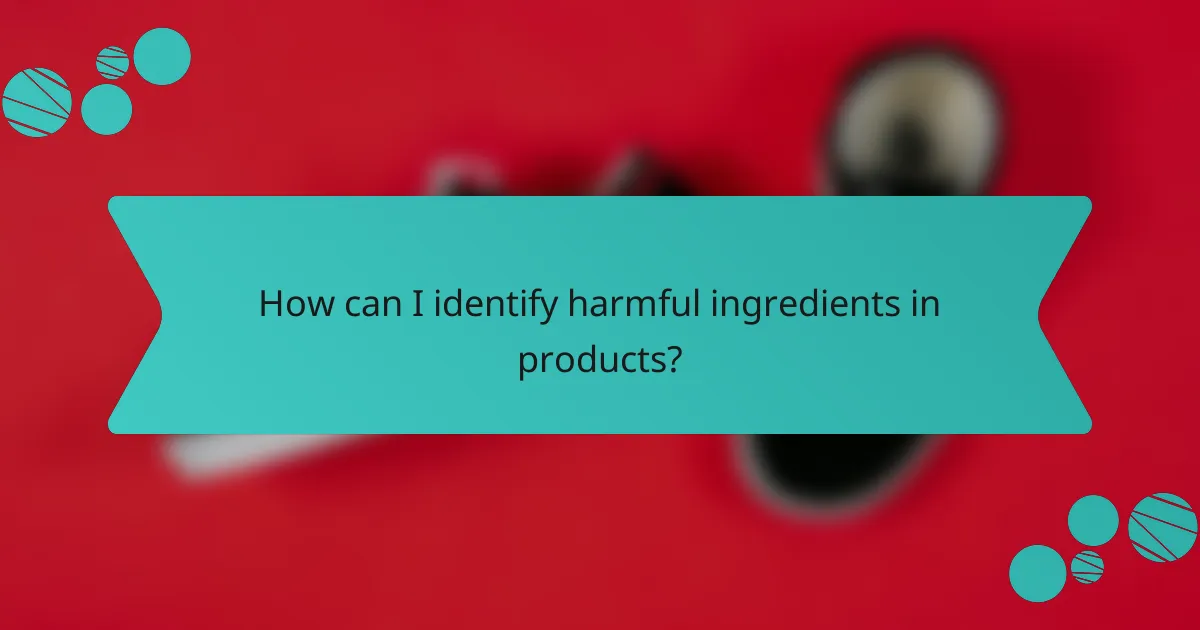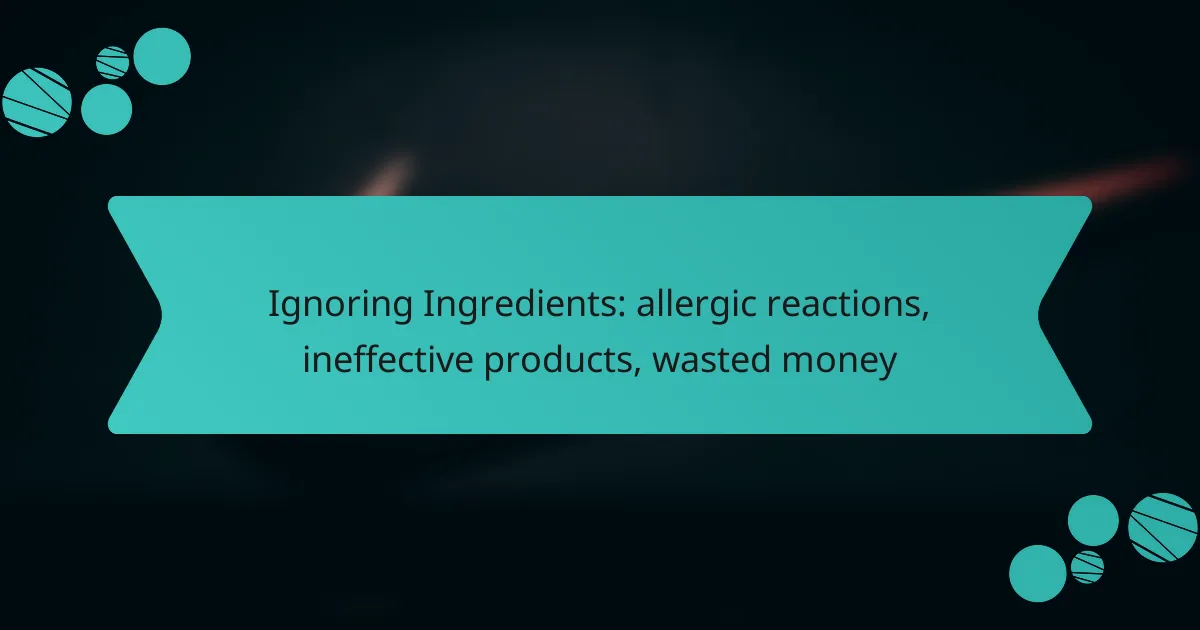Ignoring ingredients in products can lead to serious allergic reactions, ineffective results, and unnecessary expenses. By understanding the potential risks associated with certain components, consumers can make informed choices that prioritize their health and financial well-being. Careful examination of labels and seeking professional guidance are essential steps in avoiding these pitfalls.

What are the common allergic reactions to ignored ingredients?
Common allergic reactions to ignored ingredients can range from mild skin irritations to severe life-threatening conditions. Recognizing these reactions is crucial for avoiding health risks and ensuring safety when using products containing allergens.
Skin rashes and hives
Skin rashes and hives are among the most frequent allergic reactions. These can manifest as red, itchy welts or patches on the skin, often appearing shortly after exposure to an allergen. Common triggers include certain preservatives, fragrances, and dyes found in cosmetics and personal care products.
To minimize the risk, always check ingredient labels and perform patch tests before using new products. If you develop a rash, discontinue use immediately and consult a healthcare professional for appropriate treatment.
Respiratory issues
Respiratory issues can arise from inhaling allergens present in products like cleaning supplies or air fresheners. Symptoms may include sneezing, coughing, wheezing, or difficulty breathing, particularly in individuals with asthma or other respiratory conditions.
To avoid these reactions, ensure proper ventilation when using such products and consider opting for fragrance-free or hypoallergenic alternatives. If respiratory symptoms occur, seek fresh air and medical attention if they persist.
Gastrointestinal disturbances
Gastrointestinal disturbances, such as nausea, vomiting, or diarrhea, can occur when allergens are ingested. This is particularly relevant for food products that may contain hidden allergens like nuts, gluten, or dairy.
Always read labels carefully and be aware of cross-contamination risks. If you experience gastrointestinal symptoms after consuming a product, consult a healthcare provider to determine the cause and receive appropriate care.
Anaphylaxis risks
Anaphylaxis is a severe, potentially life-threatening allergic reaction that can occur within minutes of exposure to an allergen. Common triggers include certain foods, insect stings, and medications, but can also arise from ignored ingredients in personal care products.
Individuals with known allergies should carry an epinephrine auto-injector and wear medical identification. Immediate medical attention is essential if anaphylaxis is suspected, as it requires prompt treatment to prevent serious complications.

How can I identify harmful ingredients in products?
Identifying harmful ingredients in products involves careful examination of labels, utilizing technology, and seeking professional advice. By being proactive, you can avoid allergic reactions, ineffective products, and wasted money.
Reading ingredient labels
Reading ingredient labels is essential for spotting harmful substances. Look for common allergens like gluten, nuts, dairy, and artificial additives. Ingredients are typically listed in descending order by weight, so pay attention to those that appear first.
Familiarize yourself with terms that indicate potential allergens, such as “hydrolyzed,” “casein,” or “sodium.” If you have known allergies, consider keeping a list of ingredients to avoid for quick reference while shopping.
Using allergen detection apps
Allergen detection apps can simplify the process of identifying harmful ingredients. These apps often allow you to scan product barcodes and receive instant feedback on potential allergens or harmful ingredients. Popular options include “ContentChecked” and “Ipiit.”
While using these apps, ensure they are regularly updated to reflect the latest product formulations. They can be particularly useful when trying new products or when shopping in unfamiliar stores.
Consulting with healthcare professionals
Consulting with healthcare professionals, such as allergists or dietitians, can provide personalized guidance on harmful ingredients. They can help you understand your specific allergies and recommend safe alternatives. Regular check-ups can also help you stay informed about new allergens.
Consider asking for a comprehensive allergy test if you suspect sensitivities. This can help you avoid products that may not be immediately obvious but could still trigger reactions.

What are the most ineffective products due to ignored ingredients?
Many products become ineffective or even harmful when key ingredients are ignored, leading to allergic reactions or wasted money. Understanding which products commonly contain problematic ingredients can help consumers make better choices.
Over-the-counter antihistamines
Over-the-counter antihistamines are often ineffective for individuals with specific allergies if they contain ingredients that trigger their sensitivities. For example, some formulations may include artificial colors or preservatives that can provoke reactions in sensitive individuals.
When choosing an antihistamine, read the ingredient list carefully. Opt for brands that offer allergen-free options or those specifically labeled for sensitive users to avoid unnecessary side effects.
Natural remedies with allergens
Natural remedies can be misleading, as they may contain allergens that are not immediately obvious. Ingredients like certain herbs or essential oils can cause allergic reactions in some people, despite being marketed as safe and healthy.
Before using any natural remedy, research its components thoroughly. Consider consulting a healthcare professional to ensure that the remedy does not contain allergens that could lead to adverse reactions.
Skincare products with irritants
Many skincare products contain irritants that can lead to allergic reactions or skin issues. Common culprits include fragrances, alcohols, and certain preservatives that can cause sensitivity, especially for those with delicate skin.
To avoid ineffective skincare products, choose formulations labeled as hypoallergenic or free from common irritants. Always perform a patch test before fully applying a new product to ensure it does not cause a negative reaction.

How can I avoid wasting money on ineffective products?
To avoid wasting money on ineffective products, focus on thorough research and informed decision-making before purchasing. Understanding product effectiveness through reviews, expert opinions, and trial options can significantly reduce the chances of buying items that do not meet your needs.
Researching product reviews
Product reviews are essential for assessing effectiveness and user satisfaction. Look for reviews on reputable websites, forums, and social media platforms where users share their experiences. Pay attention to both positive and negative feedback to get a balanced view.
When reading reviews, consider the number of ratings and the overall trend. A product with thousands of reviews and a high average rating is generally more reliable than one with only a few reviews. Be cautious of overly positive reviews that may seem fabricated.
Seeking expert recommendations
Consulting experts can provide valuable insights into product effectiveness. This could include recommendations from dermatologists, nutritionists, or other professionals relevant to the product category. They can guide you toward reputable brands and formulations that have proven results.
Additionally, consider reaching out to community groups or online forums where experts frequently participate. Their advice can help you navigate through options and avoid products that may not deliver on their promises.
Trying sample sizes first
Before committing to full-sized products, try sample sizes or travel packs. Many brands offer these smaller versions at a lower cost, allowing you to test effectiveness without a significant financial commitment. This is particularly useful for skincare and cosmetic products.
When sampling, observe your skin’s or body’s reaction over a few days. If you experience any adverse effects, discontinue use immediately. This approach minimizes the risk of wasting money on products that may not suit your needs or could cause allergic reactions.

What criteria should I consider when choosing allergy-safe products?
When selecting allergy-safe products, prioritize ingredient transparency, allergen labeling, and product certifications. Understanding these criteria helps ensure that the products you choose do not trigger allergic reactions and are effective for your needs.
Ingredient transparency
Ingredient transparency refers to the clear disclosure of all components in a product. Look for products that list ingredients in plain language, avoiding vague terms like “fragrance” or “natural flavors,” which can hide allergens.
Check for brands that provide detailed information about their sourcing and manufacturing processes. This can help you assess whether a product is truly safe for your allergies, as some manufacturers may use shared facilities that could lead to cross-contamination.
Consider using apps or websites that track ingredient safety and provide reviews based on user experiences. This can help you make informed choices and avoid products that have previously caused allergic reactions for others.
